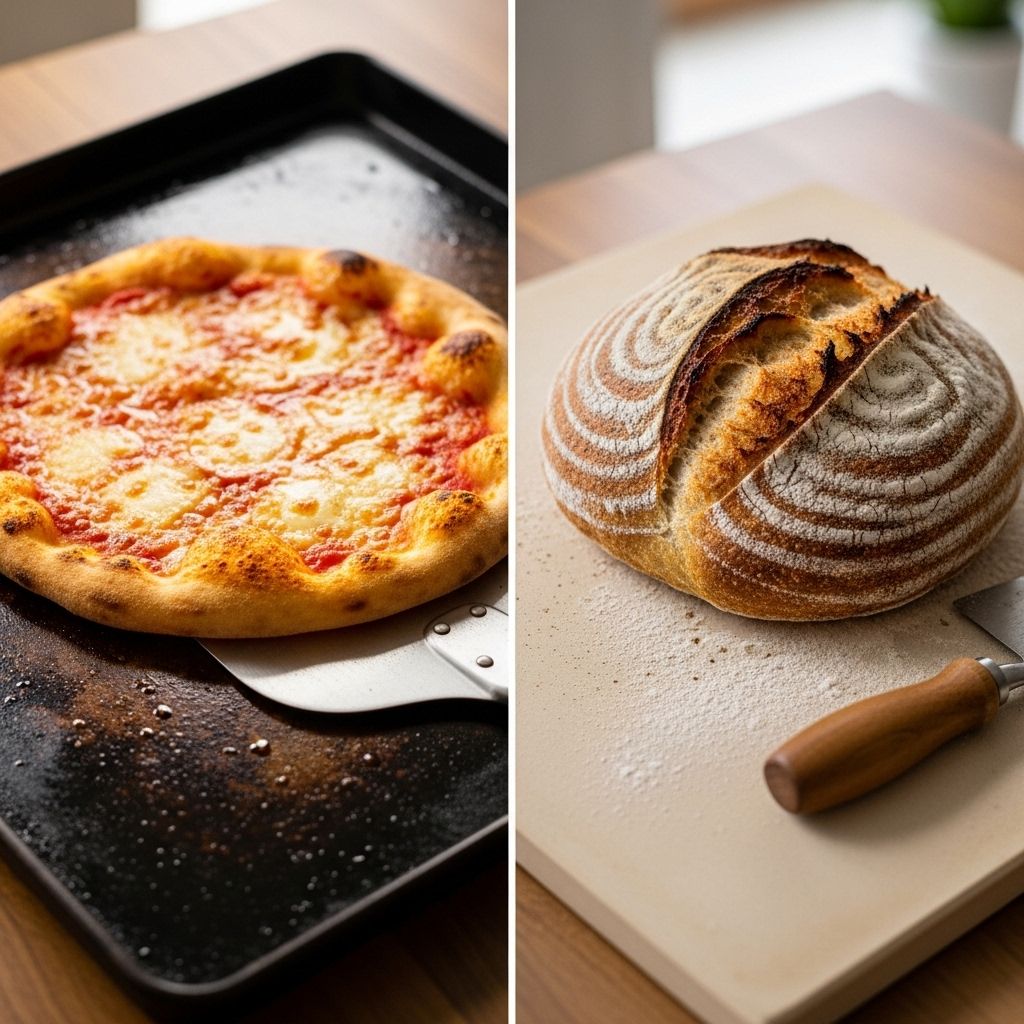Baking Steel vs. Baking Stone: Which Is Best for Perfect Pizza and Bread?
Selecting the optimal slab transforms heat delivery for crunchy bottoms and airy crumb.

If you’re aiming for bakery-quality pizza or artisanal bread right at home, you’ll notice that baking steels and baking stones are the two most recommended tools. But what sets them apart? This in-depth guide breaks down the science, pros and cons, and practical tips to help you choose the right tool for your oven and baking goals.
What Are Baking Stones and Baking Steels?
Baking stones (sometimes called pizza stones) are slabs made from ceramic, stone, or cordierite. They’ve been a kitchen staple for decades, allowing you to closely replicate the dry, intense floor heat of a brick oven.
Baking steels are relatively new: thick sheets of steel (usually carbon steel), designed to provide intense, even, and responsive heat transfer, similar to what professional ovens deliver for ultra-crisp pizza and bread crust.
How Do They Work? The Science of Heat Transfer
Baking stones and steels both function by absorbing oven heat and delivering it directly to the dough placed on top. However, there’s a critical difference in their thermal conductivity:
- Baking stones heat moderately and slowly, storing warmth and releasing it evenly, but not as intensely or rapidly as steel.
- Baking steels heat up quickly and transfer energy to dough up to 20 times faster than stone, resulting in a powerful initial burst of heat known as oven spring.
Why Does This Matter?
Thermal mass and conductivity affect your bake’s outcome:
- Higher conductivity (steel): Blistered, well-browned, and crispy crusts, faster baking, and better rise.
- Lower conductivity (stone): Good crust when thoroughly preheated, but bakes longer and may yield paler, softer bottoms.
Performance Comparison: Pizza, Bread, and More
For Pizza
| Feature | Baking Stone | Baking Steel |
|---|---|---|
| Crust | Decent, chewy, needs longer bake; can be pale if oven’s not hot enough | Blistered, extremely crisp, beautifully browned |
| Oven Spring | Moderate | More pronounced, bigger bubbles, airy crumb |
| Preheat Time | Long (30–45 minutes typical) | Faster (15–30 minutes); holds heat longer too |
| Bake Time for Pizza | 7–10 minutes | 4–7 minutes |
| Durability | Prone to cracking from rapid temperature changes or accidental drops | Nearly indestructible; can also be used on grill or as a cooktop griddle |
| Maintenance | Easy—wash with water, air dry | Requires seasoning (like cast iron); avoid soap or soaking in water |
| Weight | Lighter, easy to move | Heavy, more cumbersome |
| Cost | Budget-friendly | More expensive (but lasts a lifetime) |
For Bread and Other Baking
- Baking stones excel at holding a steadier, gentler heat, which is helpful for rustic, slow-baked artisan breads.
- Baking steels can do everything a stone does, but often better and faster—chewy bagels, cookies, even use as a griddle for burgers and breakfast.
Pros and Cons Summary
Baking Stone
- Pros:
- More affordable
- Lighter and easier to maneuver
- No seasoning or special care needed; won’t rust
- Cons:
- Slower to preheat
- Heat transfer less intense; crust can be softer or paler
- Prone to cracking (thermal shock over time or accidental drops)
Baking Steel
- Pros:
- Heats rapidly and transfers energy efficiently; best for blistered, crisp results
- Extremely durable—nearly impossible to damage
- Multipurpose—griddle, grill, freezer slab
- Holds heat longer for batch baking
- Cons:
- Heavier and bulkier; more difficult to handle
- Needs seasoning and care to prevent rust
- Higher initial cost (but lasts forever)
Durability and Maintenance
Baking Stone Durability
While affordable and lightweight, baking stones can crack when exposed to rapid temperature shifts or accidental drops. Their expected lifespan varies based on usage and care but is generally much shorter than steel.
Baking Steel Durability
Baking steels are nearly indestructible. They are immune to breaking or chipping, and can handle direct flame or grilling conditions. However, they require periodic seasoning with oil to prevent rust. Treat them as you would cast iron—never soak, and always dry thoroughly.
Which Should You Choose?
The best choice depends on your priorities, baking frequency, and expectations:
- For intense, crispy pizza and the fastest, most dramatic results (especially in standard home ovens), baking steel is the superior tool.
- If you mainly bake bread and value gentle heat and affordability, or want a lighter tool, baking stone remains a reliable option.
Consider These Factors
- Budget: Stones are cheaper upfront, steels cost more but last longer.
- Weight and Handling: Stones are convenient, steels require some muscle.
- Care Level: Stones are low-maintenance; steels need seasoning, but reward care with lifetime use.
- Versatility: Both are great for pizza and bread; steel offers bonus functions like smash burgers and as a griddle.
- Oven Compatibility: Most standard ovens fit either tool, but always check dimensions before purchase.
Tips for Using Baking Steels and Baking Stones
- Preheat thoroughly: Both stones and steels deliver their best results when allowed to preheat for at least 45 minutes on the top rack for pizza.
- Use parchment or cornmeal: This helps prevent sticking, especially when launching the dough onto steel.
- Rotate during bake: For even browning, consider rotating pizzas or bread halfway through the baking time.
- Cleaning Stones: Avoid soap. Rinse with hot water, scrape off stuck bits, and air dry thoroughly.
- Cleaning Steels: Use a grill brush or steel wool for stuck-on bits, avoid soap, and dry immediately. Season with oil every few months.
- Multipurpose use: Use
References
- https://gastrotools.com/blogs/guides/what-is-the-difference-between-a-baking-stone-and-a-baking-steel
- https://bakingsteel.com/blogs/recipes/baking-steel-vs-pizza-stone-the-ultimate-guide-for-home-pizza
- https://cookingsteels.com
- https://www.youtube.com/watch?v=yIFy30PHfzM
- https://www.youtube.com/watch?v=C1gDn-nQ-3U
Read full bio of medha deb












